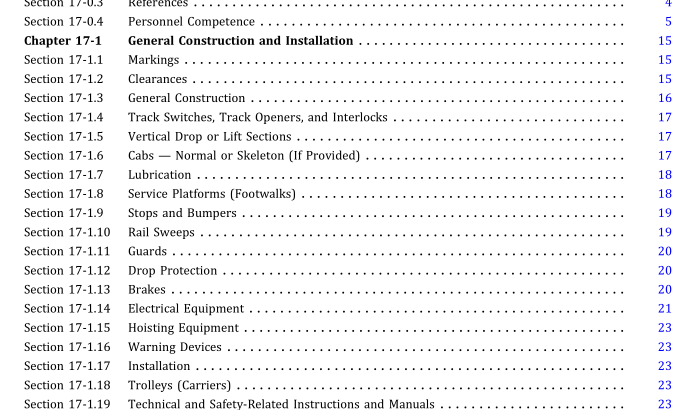ASME B30.17-2020 pdf free download.Cranes and Monorails (With Underhung Trolley or Bridge) Safety Standard for Cableways, Cranes, Derricks, Hoists, Hooks, Jacks, and Slings
SECTION 17-0.1: SCOPE OF B30.17 Volume B30.17 includes provisions that apply to the construction, installation, operation, inspection, testing, and maintenance of hand-operated and power-operated overhead cranes and monorail systems with an under- hung trolley and/or bridge.
These cranes and monorail systems shall supportone or more hoists used for vertical lifting and lowering offreely suspended, unguided loads, and include top running and underhung bridge cranes, gantry cranes, traveling wall cranes, jib cranes, polar gantry cranes, portable gantries, other cranes having the same fundamental characteristics, and monorail systems including trolleys (carriers) and end trucks. Track sections and their support systems for monorail systems, runways and their support systems for under- hung cranes, and runway rails for top running cranes are also within the scope of this Volume. Provisions for similar equipment used for a special purpose, such as, but not limited to, nonvertical lifting service, lifting a guided load, or lifting personnel, are not included in this Volume.
SECTION 17-0.2: ð20Þ DEFINITIONS abnormaloperating conditions: environmental conditions thatare unfavorable, harmful, or detrimental to or for the operation ofthe crane or trolley, such as excessively high orlowambienttemperatures,exposureto weather, corro- sivefumes,dust-ormoisture-ladenatmospheres,andhaz- ardous locations.
below-the-hook lifting device: a device used for attaching loads to a hoist. The device maycontain components such as slings, hooks, and rigginghardware addressed byother ASME B30 Volumes or other standards.
brake: a device, other than a motor, used for retarding or stopping motion by friction or power means. braking, hydraulic: a method of controlling or reducing speed by means of displacement of a liquid. braking, mechanical: a method ofcontrolling or reducing speed by friction.
braking, pneumatic: a method ofcontrollingorpoweringa brake by means of compressed gas. braking means: a method or device used for stopping/ holding motion by friction or power.
bridge: the part ofan overhead crane consisting ofone or more girders, trucks, and (if applicable) a drive mechanism that carries the trolley(s). bridge girder: a crane member on which a trolley or trol- leys travel horizontally, mounted between and supported by the end trucks. bridgetravel:thecranemovementinadirectionparallelto the crane runway.
bumper (buffer): a device for reducing impact when a moving crane or trolley reaches the end of its permitted travel, or when two moving cranes or trolleys come into contact. This device maybe attached to the bridge, trolley, or runway stop. cab: an operator’s compartment attached to a crane or trolley. cab, normal: an operator’s compartmentused for control- ling a cab-operated crane or trolley.
cab, skeleton: an operator’s compartment used for occa- sional cab operation of, normally, a floor- orremote-oper- ated crane or trolley. carrier: (also known as trolley) a unit that travels on the bottom flange of a monorail track, jib boom, or bridge girder to transport a load. chain, load: the load-bearing chain in a hoist. clamp, hanger: atype ofsuspension fittingusedto support tracks fromanoverheadstructurewhichis fastenedto the structure by mechanical means rather than by welding or direct bolting.
clearance: the distance from any part of the crane to the nearest obstruction.
collectors, current: contacting devices for conducting current from runway or bridge conductors. conductors, bridge: the electrical conductors located along the bridge structure of a crane that transmit control signals and power to the trolley(s).
conductors, runway (main): the electrical conductors located along a crane runway that transmit control signals and power to the crane.
conductors (electrification): the system by which the moving equipment receives its electrical power (see Figure 17-0.2-1).ASME B30.17 pdf download.ASME B30.17-2020 pdf free download
